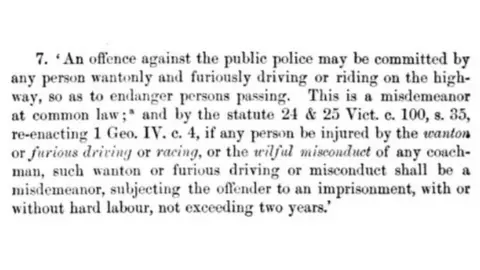Dangerous cycling law review after death crash
 Met Police
Met PoliceThe government is launching a review into whether a new law is needed to tackle dangerous cycling.
It will consider whether an equivalent offence to causing death by dangerous driving is needed for cyclists.
It comes after Charlie Alliston, who killed Kim Briggs while riding a fixed-gear bike with no front brakes, was convicted under Victorian law.
Mrs Briggs' widower Matthew Briggs welcomed the review, saying the case "highlighted a huge gap" in the law.
Alliston, 20, was cleared of manslaughter but convicted under the 19th Century offence of "wanton or furious driving".
On Monday he was sentenced to 18 months in a young offenders' institution.
After the conviction, Mr Briggs called for the introduction of new laws, including causing death by dangerous cycling.
Ministers are now seeking independent legal advice on this, with the review - covering the law in England, Scotland and Wales - due to report in the new year.
Announcing the move, the government said there had been a "series of high-profile incidents" involving cyclists and that in 2015, two pedestrians had been killed and 96 seriously injured after being hit by a bicycle.
Transport minister Jesse Norman said: "It's great that cycling has become so popular in recent years but we need to make sure that our road safety rules keep pace with this change.
"We already have strict laws that ensure that drivers who put people's lives at risk are punished but, given recent cases, it is only right for us to look at whether dangerous cyclists should face the same consequences."
He told BBC Radio 4's Today programme that the review will consider how the law should be updated "so there is a proper legal remedy if a pedestrian is seriously injured or killed by a cyclist" and whether or not there should be a new law.
But he added that was "only part of the problem" and the inquiry will consider "much wider elements of cycle safety affecting cyclists and pedestrians, but also the relationships with motorists".
The government said in this second phase of the review - which covers England but will may also impact the situation in Scotland and Wales - signage and public awareness would be among the issues looked at.
Some cycling groups point out the number of deaths caused by cyclists remains extremely low compared with the figures for cyclists and pedestrians killed and injured by motorists.
The government had been urged to act by Labour MP Heidi Alexander, Mrs Briggs' constituency MP, who said at Prime Minister's Questions that the current law was "hopelessly outdated and wholly inadequate".
Mr Briggs told BBC Breakfast that he welcomed the review and was pleased the government had "responded so swiftly".
"It seems to me there is a yawning gap in the legislation that needs to be filled," he said.
"What I want is the police and the CPS to have a coherent law to be able to reach for in the future."
But he said the call for a legislation update was "not in any way anti-cycling".
"With the increase in the number of cyclists there is of course an increase in the risk that comes with it," he said.
"Just because what happened to Kim is rare... it doesn't mean there shouldn't be a remedy in law."
He added: "If I can get something good to come out of something so tragic, then I'll have done my job."
Paul Tuohy, chief executive of campaign group Cycling UK, said the consultation was an opportunity to keep cyclists and pedestrians safer.
"Cycling UK looks forward to working with the Department for Transport on this consultation to ensure it focuses on evidenced ways that keep our most vulnerable road users safe, by addressing risks such as dangerous roads, drivers and vehicles," he said.
"The proposed review of cycling offences needs to be carried out as part of the government's promised wider review of all road traffic offences and sentencing.
"This will ensure the justice system can deal with mistakes, carelessness, recklessness and deliberately dangerous behaviour by all road users."

What is wanton and furious driving?
 Commentaries on the Laws of England
Commentaries on the Laws of EnglandAlliston was charged with an admittedly archaic offence - but it is the closest to dangerous driving a cyclist can be charged with.
Unlike a dangerous cycling charge, causing grievous bodily harm by wanton and furious driving takes into account injury.
It may sound slightly eccentric, but perhaps it is down to its wording which was coined in 1861.
Introduced under the Offences Against the Person Act, the charge was created to deter people from driving horse carriages recklessly.
It is now used when it is not possible to prosecute under the Road Traffic Act 1988 - ie, when the vehicle in the crime was not mechanically propelled - and in cases of serious injury or death caused by a cyclist's actions.
It carries a maximum penalty of two years' imprisonment and/or an unlimited fine.
Previous successful prosecutions under the offence include those against cyclists Darryl Gittoes and Darren Hall, who both knocked down pedestrians who later died.
